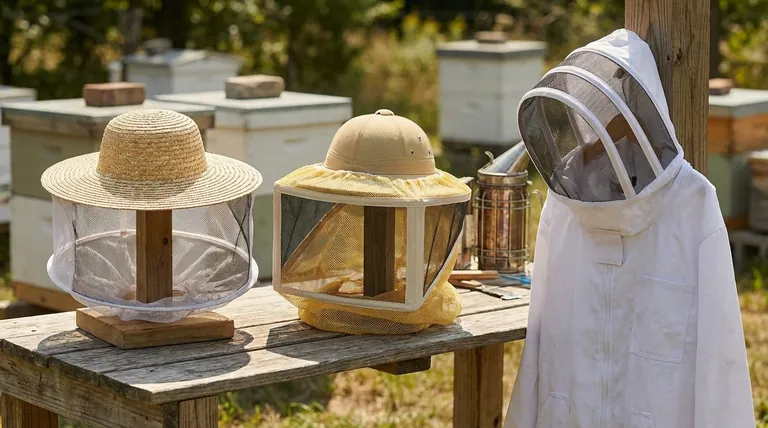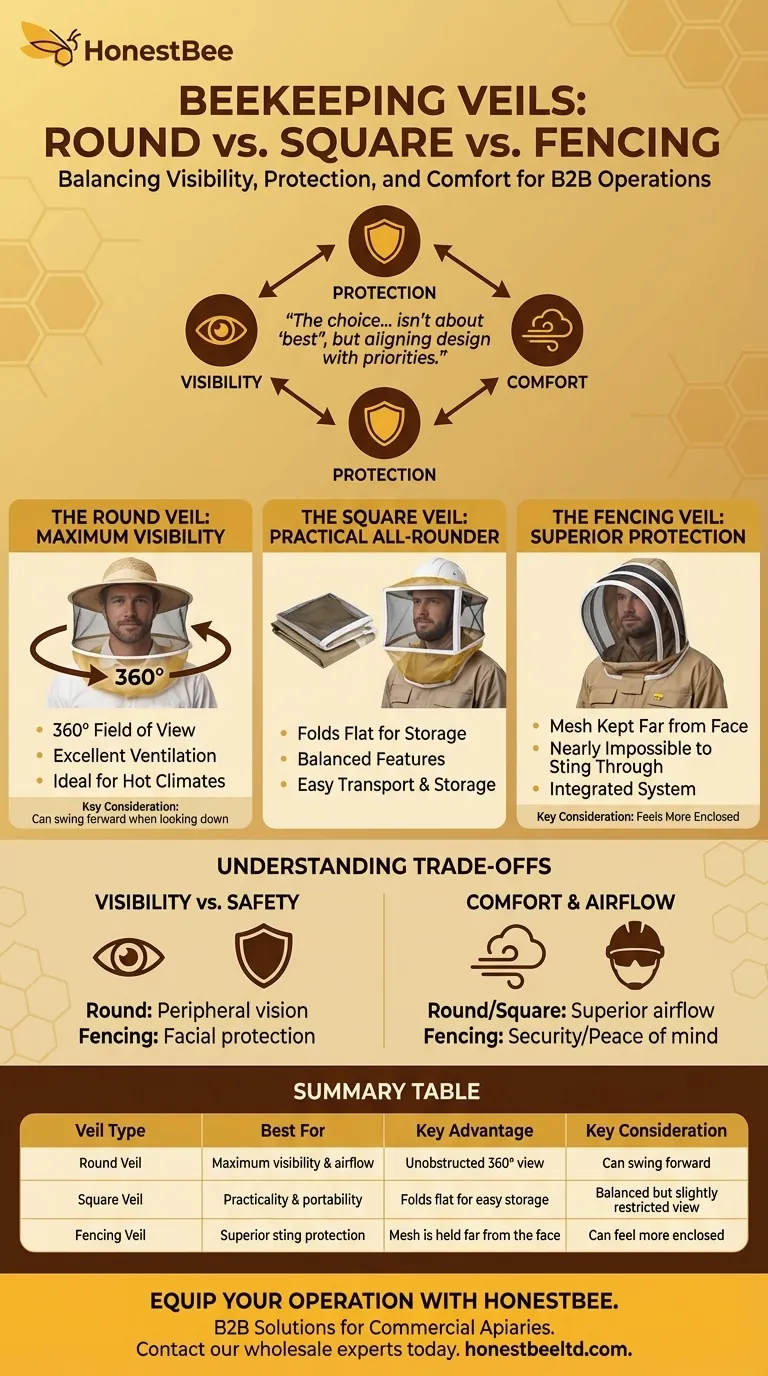At their core, the differences between round, square, and fencing veils come down to a trade-off between visibility, protection, and comfort. A round veil offers the widest, most natural field of view, a square veil provides a balance of features and is easily stored, and a fencing veil delivers the best protection by keeping the mesh away from your face.
The choice of a beekeeping veil isn't about finding the single "best" option, but about aligning the veil's design with your personal priorities for visibility, protection, and comfort during hive inspections.

A Closer Look at Each Veil Type
To understand the right choice for you, we must examine the distinct design philosophy behind each veil. Each one excels in a specific area.
The Round Veil: Maximum Visibility
The round veil is the most traditional design, resembling a wide-brimmed hat with mesh netting that drapes down on all sides.
Its key advantage is an unobstructed, 360-degree field of view. This can make you feel less enclosed and more connected to your surroundings.
This design also provides excellent ventilation, making it a popular choice for beekeepers working in very hot climates.
The Square (or Folding) Veil: The Practical All-Rounder
The square veil, often called a folding veil, is a simple but effective design. It typically drapes over a separate helmet or hat and has rigid inserts to keep the front and side mesh away from your face.
Its primary benefit is practicality. It folds flat, making it incredibly easy to store and transport.
While the view is slightly more restricted than a round veil, it still offers good visibility and ventilation, representing a solid middle-ground option.
The Fencing Veil: Superior Protection
The fencing veil is a modern design integrated directly into a beekeeping jacket or suit. It features a structured, semi-rigid frame that holds the mesh in a bowed shape, similar to a fencing mask.
This structure is its greatest strength, as it keeps the mesh far from your face, making it nearly impossible for a bee to sting through it.
This robust protection is why it has become the standard for many beekeepers, especially those who prioritize safety above all else.
Understanding the Trade-offs
No single veil is perfect. Your decision depends on which compromises you are willing to make.
Visibility vs. Safety
The open design of a round veil provides the best peripheral vision, but its loose fit means it can be brushed against your face by a branch or a sudden movement.
A fencing veil offers unparalleled facial protection, but the structure can create minor blind spots or catch glare from the sun at certain angles.
Comfort and Airflow
Both round and square veils generally offer superior airflow due to their less-structured nature. They rest on a hat, allowing air to circulate freely.
The fencing veil, while well-ventilated, can feel more enclosed to some users. Its main comfort benefit is psychological—the peace of mind that comes from knowing your face is well-protected.
Practicality in the Field
A significant drawback of the round veil is its tendency to swing forward or fall off your head when you look straight down into a hive body.
The fencing veil is permanently attached to its jacket, making it a secure, all-in-one system. However, this means you cannot simply swap out the veil if it gets damaged.
Making the Right Choice for Your Goal
Select your veil based on what you value most during your time with the bees.
- If your primary focus is an open feel and maximum airflow: The Round Veil is an excellent choice, but be mindful of securing your hat properly.
- If your primary focus is the best possible protection against facial stings: The Fencing Veil is the undisputed leader and the modern standard for safety.
- If your primary focus is a versatile, portable, and cost-effective option: The Square Veil provides a reliable balance of visibility, protection, and convenience.
Choosing the right veil is a personal decision that empowers you to work confidently and comfortably in your apiary.
Summary Table:
| Veil Type | Best For | Key Advantage | Key Consideration |
|---|---|---|---|
| Round Veil | Maximum visibility & airflow | Unobstructed 360° view | Can swing forward when looking down |
| Square Veil | Practicality & portability | Folds flat for easy storage | Balanced but slightly restricted view |
| Fencing Veil | Superior sting protection | Mesh is held far from the face | Can feel more enclosed |
Equip Your Operation with the Right Protection
Choosing the correct veil is critical for the safety and efficiency of your beekeeping work. At HONESTBEE, we supply durable, high-quality beekeeping veils and equipment designed for the demands of commercial apiaries and distributors.
Let us help you select the perfect gear to keep your team safe and productive. Contact our wholesale experts today to discuss your needs and get a quote.
Visual Guide

Related Products
- Square Folding Bee Hat Veil with String for Beekeeping
- Heavy Duty Cowboy Beekeeper Hat with Visibility Veil Outdoor Professional Beekeeping Protective Gear
- Beekeeper Cowboy Hat and Veil for Beekeeping
- Cotton Beekeeping Suit and Round Hat with Veil Bee Keeper Protective Gear
- Friendly Bee Mascot Costume Vibrant Engaging Promotional Asset
People Also Ask
- What are the different types of protective veils for beekeeping? Choose the Right Protection for Your Apiary
- Why is it recommended to always wear a veil when working with bees? Protect Your Face and Eyes from Stings
- Why are a hat and veil considered the most important parts of beekeeping protective gear? Essential Protection for Your Face and Confidence
- How can beekeeping supplies and accessories enhance the hobby? Essential Tools for Safe & Rewarding Beekeeping
- How should the beekeeping hat veil be cleaned? The Only Safe Method to Preserve Protection



















